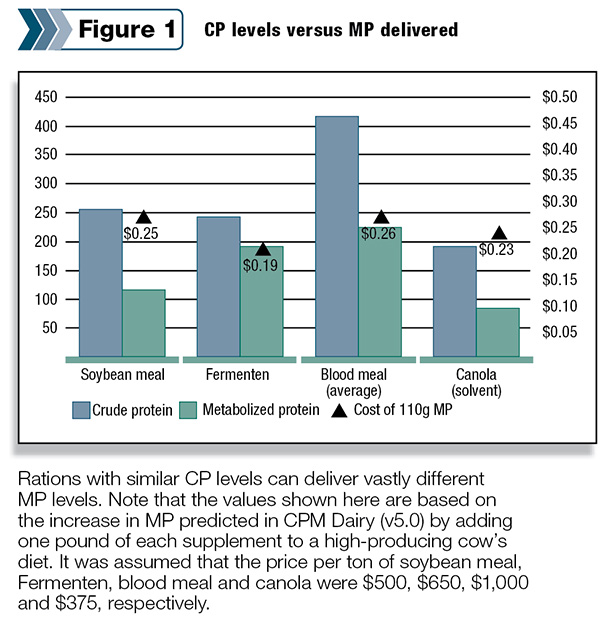This data allows producers to deliberately and carefully feed groups of cows according to their specific needs in order to maximize production and efficiency while supporting cow health and productivity.
Still, they could do even better, especially when it comes to ration protein accuracy.
Crude protein is only part of the story
Dairy cow feedstuffs contain many different proteins at various levels and quality. For years, crude protein (CP) content was used for formulating dairy diets as one way to overcome this variability.
Many researchers also thought that the high-quality microbial protein (MCP) synthesized in the rumen would complement deficiencies in the quality of dietary protein that escaped rumen fermentation.
“Research conducted in the 1960s showed that the rumen was capable of supplying all of the protein required by the cow producing up to 10,000 pounds (4,536 kilograms) of milk annually,” notes Dr. Gabriella Varga, Penn State University dairy nutrition specialist.
But cows today milk nearly triple that amount, meaning the rumen does not have the capacity to supply all of the protein needs of these cows.
Even more importantly, CP does not indicate that what is supplied to the animal is useful for productive functions. CP values only measure the nitrogen content of a feedstuff, which is the building block of proteins.
It does not indicate if the nitrogen is an amino acid, the non-protein nitrogen level, the bioavailability or degradability of the nitrogen in the rumen, how much of the nitrogen escapes the rumen or if it is bound nitrogen.
In short, there is no dietary requirement for CP, yet this value still plays a significant role in dairy ration ingredient use and purchase decisions.
CP values today are like total digestible nutrient (TDN) values of a decade or more ago – it was a good measure at the time, but now producers and nutritionists can do better because of improved tools, enhanced research and more knowledge.
CP is worth monitoring for a number of reasons, but it should not be the target value for ration balancing or feed purchase decisions.
Cows need metabolizable protein
It is what’s in the protein and its impact on the cow, rumen and bacterial output performance that really matters.
A combination of rumen bypass protein, endogenous protein and bacterial protein reaches the intestine and is available for absorption. This is metabolizable protein (MP): it is what the animal needs and should be the protein basis used to formulate rations.
MP supplies the amino acids the cows need for growth, to maintain body condition, produce milk and support fetal growth. MP is defined as the true protein that is digested postruminally, along with its amino acid components that are absorbed by the small intestine.
Absorbed amino acids are used for the synthesis of proteins, which are essential for an animal’s growth, reproduction and milk production.
The Dairy National Research Council (2001) has suggested moving to an MP system to better define and refine protein formulation and utilization. “This system fits with the biology of the cow,” says Dr. Larry Chase, extension dairy nutrition specialist at Cornell University.
Stop overfeeding protein
Of utmost concern to dairy producers should be that when they base diets on crude protein, they are likely overfeeding or underfeeding protein to cows. Either way, cows likely do not receive what they need.
For example, a ration may meet a cow’s MP needs with varying CP levels – you can meet MP needs at 15 percent CP or 18 percent CP depending on the ration and feedstuffs included.
Plus, overfeeding of protein results in excessive nitrogen being excreted by the cow, which has environmental impacts for dairies in regard to the release of nitrogen and ammonia emissions – both of which are under increasing scrutiny.
Furthermore, when buying feedstuffs based on CP, producers are not being efficient with their feed dollars, as shown by Figure 1.
What’s stopping you?
Balancing rations based on MP is increasing in the dairy industry, but everyone has not yet embraced this concept.
The challenge is: This system is not as simple as it is with CP and requires the use of computer programs to calculate both MP requirements and the MP supplied by feeds and microbial protein synthesized in the rumen, explains Chase.
Still, he says, the industry is changing to an MP approach.
Successful implementation will require working more closely with nutritionists and other nutritional partners to determine the MP value of feedstuffs under consideration for ration inclusion.
It also means working closely with these partners during purchase decisions to help producers make the most economical decisions when determining which feed ingredients to buy.
But don’t let the change in this relationship throw you. “This system should provide an opportunity to improve the
efficiency of protein use in dairy cattle,” Chase concludes. That improvement can have long-lasting impacts on your dairy’s productivity and profitability. PD
References omitted due to space but are available upon request. Click here to email an editor.

Elliot Block
Senior Manager of Technology
Arm & Hammer Animal Nutrition








